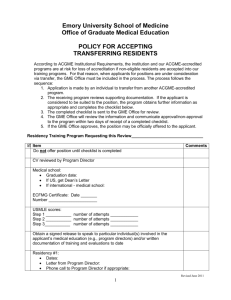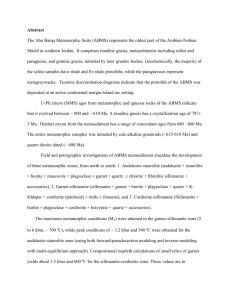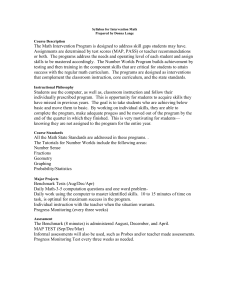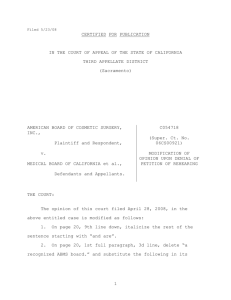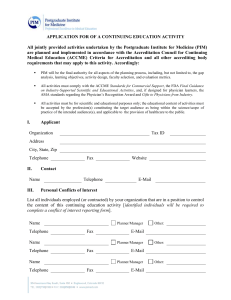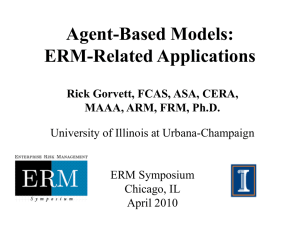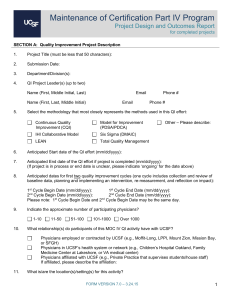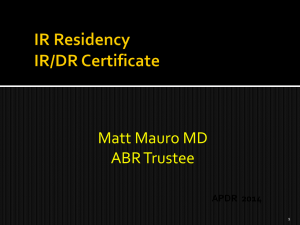in the united states district court
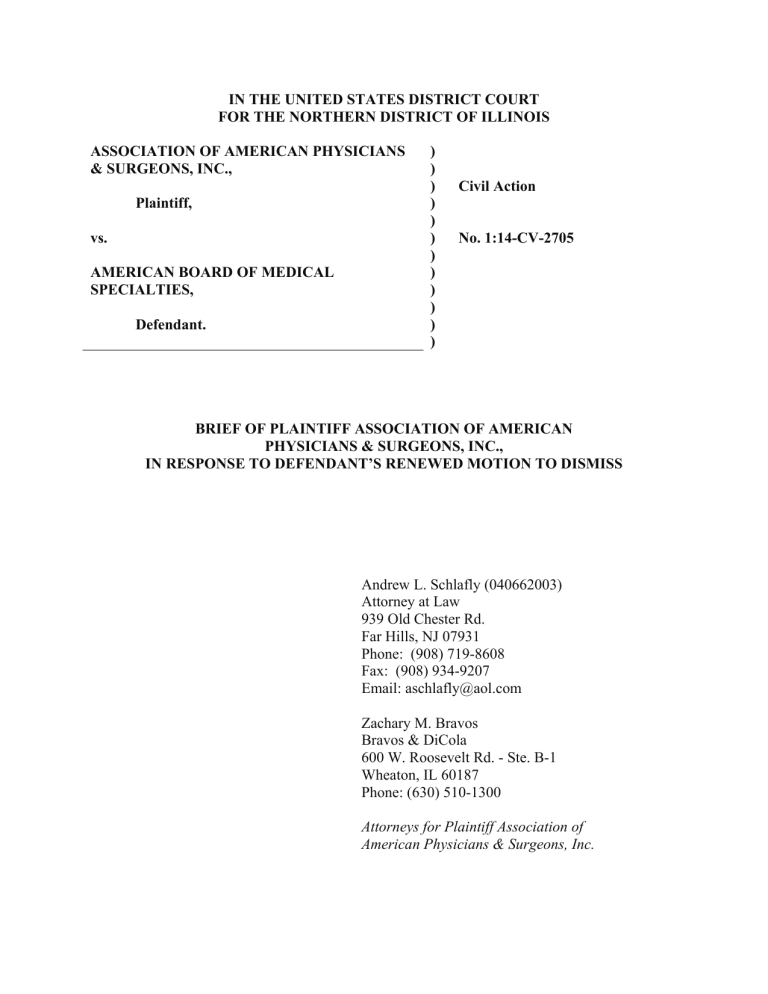
IN THE UNITED STATES DISTRICT COURT
FOR THE NORTHERN DISTRICT OF ILLINOIS
ASSOCIATION OF AMERICAN PHYSICIANS
& SURGEONS, INC.,
)
)
) Civil Action
Plaintiff, vs.
AMERICAN BOARD OF MEDICAL
SPECIALTIES,
Defendant.
)
)
)
)
)
)
)
)
)
No. 1:14-CV-2705
BRIEF OF PLAINTIFF ASSOCIATION OF AMERICAN
PHYSICIANS & SURGEONS, INC.,
IN RESPONSE TO DEFENDANT’S RENEWED MOTION TO DISMISS
Andrew L. Schlafly (040662003)
Attorney at Law
939 Old Chester Rd.
Far Hills, NJ 07931
Phone: (908) 719-8608
Fax: 934-9207
Zachary M. Bravos
Bravos & DiCola
600 W. Roosevelt Rd. - Ste. B-1
Wheaton, IL 60187
Phone: (630) 510-1300
Attorneys for Plaintiff Association of
American Physicians & Surgeons, Inc.
TABLE OF CONTENTS
Table of Contents ............................................................................................................................ ii
Table of Authorities ....................................................................................................................... iii
Introduction .....................................................................................................................................1
Statement of Facts ............................................................................................................................2
Argument .........................................................................................................................................7
I. The Legal Standard Applicable to Defendant’s Motion ........................................................7
II. There “Nonnegligible Probability” that the ABMS Agreements and
Conduct Transgress the Sherman Act, and Thus the Complaint Properly
Alleges a Claim under Fed. R. Civ. P. 12(b)(6) ....................................................................7
A. Restraint of Trade is Properly Alleged .....................................................................8
B. Plaintiff AAPS Has Antitrust Injury ........................................................................12
III. Plaintiff AAPS States a Valid Claim for Negligent Misrepresentation .............................14
Conclusion .....................................................................................................................................15
Certification of Service ..................................................................................................................17 ii
TABLE OF AUTHORITIES
Cases Pages
Allied Tube & Conduit Corp. v. Indian Head , 486 U.S. 492 (1988) ........................................... 8, 9
Am. Needle, Inc. v. NFL , 560 U.S. 183 (2010) ........................................................................... 9, 13
American Society of Mechanical Engineers, Inc.
v. Hydrolevel Corp.
,
456 U.S. 556 (1982) ............................................................................................................. 8
Ashcroft v. Iqbal , 556 U.S. 662 (2009) ....................................................................................... 7, 13
Ass’n of Am. Physicians & Surgs. v. Tex. Med. Bd.
, 627 F.3d 547 (5th Cir. 2010) ...................... 13
Atkins v. City of Chicago , 631 F.3d 823 (7th Cir. 2011) .................................................................. 7
Beam v. IPCO Corp.
, 838 F.2d 242 (7th Cir. 1988) ....................................................................... 11
Bell Atlantic Corp. v. Twombly , 550 U.S. 544 (2007) ............................................................. passim
Bishara v. American Bd. of Orthopaedic Surgery, Inc.
,
41986 U.S. Dist. LEXIS 15839 (N.D. Ill. Dec. 30, 1986) ................................................ 10
Brader v. Allegheny Gen. Hosp.
, 64 F.3d 869 (3d Cir. 1995) ........................................................ 12
Brooks v. Pactiv Corp.
, 729 F.3d 758 (7th Cir. 2013) ...................................................................... 7
Brunswick Corp. v. Pueblo Bowl-O-Mat, Inc.
, 429 U.S. 477 (1977) ............................................ 12
Carter v. Stanton , 405 U.S. 669 (1972) .........................................................................................11
Castrol, Inc. v. Pennzoil Co.
, 987 F.2d 939 (3d Cir. 1993) ........................................................... 15
Clamp-All Corp. v. Cast Iron Soil Pipe Inst.
,
851 F.2d 478 (1st Cir. 1988) ............................................................................................... 12
Consolidated Metal Products, Inc. v. American Petroleum Institute ,
846 F.2d 284 (5th Cir. 1988) .............................................................................................12
DeGregorio v. American Board of Internal Medicine, No. 92-cv-4924 (D.N.J. Oct. 1, 1993)
(unpublished, but cited at Def. Br. 9) (Report & Recommendation), rev’d in part ,
844 F. Supp. 186 (D.N.J. 1994) .......................................................................................... 10
Ezell v. City of Chicago , 651 F.3d 684 (7th Cir. 2011) .................................................................13 iii
Fashion Originators’ Guild of America, Inc. v. FTC , 312 U.S. 457 (1941).................................... 9
FTC v. Indiana Federation of Dentists , 476 U.S. 447 (1986).......................................................... 8
Indian Brand Farms, Inc. v. Novartis Crop Prot., Inc.
, 617 F.3d 207 (3d Cir. 2010) .................. 15
Marrese v. American Academy of Orthopaedic Surgeons ,
No. 91-1366, 1992 U.S. App. LEXIS 25530 (7 th Cir. Oct. 1, 1992) ................................. 10
Massachusetts Sch. of Law at Andover v. ABA ,
107 F.3d 1026 (3d Cir. 1997) .............................................................................................. 12
McCall v. Metropolitan Life Ins.
, 956 F. Supp. 1172 (D.N.J. 1996) .......................................14, 15
McDaniel v. Appraisal Inst.
, 117 F.3d 421 (9th Cir. 1997) ...........................................................12
McGlinchy v. Shell Chemical Co.
, 845 F.2d 802 (9th Cir. 1988) ..................................................
13
McReynolds v. Merrill Lynch & Co ., 694 F.3d 873 (7th Cir. 2012) ................................................ 7
Menominee Indian Tribe of Wisconsin v. Thompson , 161 F.3d 449 (7th Cir. 1998) .....................11
National Family Ins. Co. v. Exchange Nat’l Bank ,
474 F.2d 237 (7th Cir.), cert. denied , 414 U.S. 825 (1973) ............................................... 11
Oksanen v. Page Memorial Hosp.
,
945 F.2d 696 (4th Cir. 1991) .............................................................................................. 11
Patel v. American Bd. of Psychiatry & Neurology, Inc.
,
1989 U.S. Dist. LEXIS 14011 (N.D. Ill. Nov. 20, 1989) .............................................. 10-11
Poindexter v. American Bd. of Surgery
911 F. Supp. 1510 (N.D. Ga. 1994) .............................................................................. 11, 12
Radiant Burners, Inc.
v. Peoples Gas Light & Coke Co.
,
364 U.S. 656 (1961) .............................................................................................................. 8
Sanjuan v. American Bd. of Psychiatry & Neurology ,
40 F.3d 247 (7th Cir. 1994) ................................................................................................. 11
Schachar v. American Academy of Ophthalmology , 870 F.2d 397 (7th Cir. 1989) .................. 9-10
Statutes and Regulations
15 U.S.C. § 1 ...................................................................................................................................... 6 iv
Fed. R. Civ. P. 12(b) ........................................................................................................................ 11
Fed. R. Civ. P. 12(b)(6) ................................................................................................................. ii, 7
Seventh Circuit Rule 32.1(d) ........................................................................................................... 10
Other
7 P. Areeda, Antitrust Law P1503 (1986) ......................................................................................... 9 http://certificationmatters.org/faqs.aspx
................................................................................................. 3 v
Plaintiff Association of American Physicians & Surgeons, Inc. (“AAPS” or “Plaintiff”), by and through its counsel, hereby opposes the renewed motion to dismiss and brief [D.I. 30, 31] filed by Defendant American Board of Medical Specialties (“ABMS” or “Defendant”):
INTRODUCTION
Defendant ABMS has entered into numerous lucrative agreements with at least two dozen other entities to impose on physicians “requirements”, in ABMS’s own terminology
(Compl. ¶¶ 47, 80), of maintenance of board certification. Physicians who do not comply, perhaps due to family or work commitments, with the expensive and extremely time-consuming
“requirements” that have no proven benefit for patient care, are then often excluded from hospitals and insurance plans. If ABMS has its way, then the physicians could even lose their medical license. ABMS’s program reduces the supply of physicians available to the public in two ways: by soaking up substantial portions of their time and, if the physicians are unable to fully comply with ABMS’s requirements, by causing their exclusion from key markets.
ABMS calls its program ABMS Maintenance of Certification®, known as “ABMS
MOC®” for short. It is a trademarked, proprietary, lucrative program that works as follows.
Either a physician spends hundreds of hours and thousands of dollars satisfying the demands of
ABMS and the two-dozen other entities which are in agreements to impose this scheme, or the physician loses his board certification. He or she is then automatically kicked off of hospital medical staffs, removed from health insurance plans, and publicly disparaged by ABMS as someone who is “Not Meeting MOC Requirements.” This scheme violates the Sherman Act.
In its motion to dismiss, ABMS tries hard to portray its ABMS MOC® in a positive light.
But ABMS is not merely acting alone to increase its revenue. ABMS has entered into agreements with other entities to compel physicians to comply with “MOC Requirements,” and
thereby increase the revenue of ABMS, its co-conspirators, and their executives. ABMS has coordinated with others to encourage the public, hospitals and insurance plans to avoid physicians who have not spent time and money for the benefit of ABMS and the companies in agreements with it.
For example, a member of AAPS identified as “J.E.” in the Complaint was automatically excluded from a hospital simply because he did not spend substantial time and money complying with the onerous burdens imposed by the many agreements entered into by ABMS. Solely as a result of the agreements entered into by ABMS with other private entities, the patients of J.E. who are taken to the local hospital, perhaps in an emergency, now cannot be seen and treated by
J.E. there. This is a restraint of trade that reduces the availability of good physicians to the public. This constitutes a reduction in consumer choice and the output of medical services, due to Defendant ABMS’s conduct. ABMS even seeks to tie medical licensure to its proprietary program, such that physicians will not be able to renew their license unless they comply with the requirements imposed by ABMS and its co-conspirators. Section One of the Sherman Act prohibits conspiracies that reduce output, which is precisely what the ABMS MOC® program and the agreements underlying it do. The availability of physicians declines because of the
ABMS MOC program; it restrains trade and reduces the supply of physicians to patients.
STATEMENT OF FACTS
Founded in 1943, Plaintiff AAPS is a membership organization of thousands of physicians. (Compl. ¶ 4) Defendant ABMS is a nonprofit entity incorporated in Illinois. ( Id.
¶
5) ABMS has entered into agreements with at least two dozen separate corporations to impose on physicians a recertification program known as “ABMS MOC®,” which these organizations have implemented against physicians. ( Id. ¶¶ 10, 12) These agreements harm members of
2
AAPS by excluding and marginalizing physicians who decline to purchase and participate in the
ABMS MOC program. ( Id. ¶ 4)
Defendant ABMS has acted in concert with The Joint Commission, a private company that accredits more than 20,000 health care organizations and hospitals, including the Somerset
Medical Center in New Jersey (SMC), to require formal recertification as a condition of having medical staff privileges. ( Id. ¶ 13) In November 2009 and afterward, ABMS and several of its co-conspirators obtained agreement by The Joint Commission that hospitals must enforce requirements against physicians for renewal of their medical staff privileges, and that these requirements should include some or all of Defendant’s ABMS MOC® program. ( Id. ¶ 14)
Many hospitals comply by excluding good physicians from their medical staffs. ( Id. ¶ 15) In addition, Defendant ABMS has acted in concert with other groups to induce health insurers to
“use Board Certification by an ABMS Member Board as an essential tool to assess physician credentials within a given medical specialty.” ( Id. ¶ 16, quoting ABMS’s own website
1
) There is, in fact, no benefit to patient care from Defendant’s ABMS MOC® recertification program.
( Id. ¶ 17) Indeed, one of the co-conspirators of ABMS has even offered ten years of recertification for a substantial cash payment in lieu of an examination. ( Id. ¶ 18)
ABMS has conspired to exclude physicians from medical staffs if they do not purchase
ABMS’s product, and this exclusion is detrimental to hospitalized patients who wish to be seen by their own physicians. ( Id. ¶ 21-22) The ABMS MOC® program imposes far greater burdens than any analogous program in any other profession, and surveys demonstrate that an overwhelming majority of physicians – more than 90% in one survey – find ABMS’s program to be unjustified. ( Id. ¶ 24) There is no evidence that ABMS’s program advances any legitimate
1 http://certificationmatters.org/faqs.aspx
(viewed July 20, 2013, and again June 1, 2014).
3
goal for patient care, and the primary purpose of the implementation of the MOC program is to enrich executives at ABMS and other entities with which ABMS has conspired. ( Id. ¶¶ 25-26)
ABMS’s agreements and actions resulted in the unjustified exclusion of a physician member of AAPS (“J.E.”) from the medical staff at SMC, a hospital in New Jersey. ( Id. ¶ 29)
Physician J.E. had been on the SMC medical staff to treat patients there for twenty-nine (29) years. ( Id. ¶ 30) J.E. had been board certified by the predecessor to The American Board of
Family Medicine (“ABFM”), but SMC refused to allow J.E. to remain on its medical staff unless he complied with the burdensome, impractical requirements of ABMS MOC®. ( Id. ¶¶ 31-32,
34) ABFM is one of the two-dozen entities that agreed with ABMS to require ABMS MOC®.
( Id. ¶ 33) These burdensome requirements imposed by ABMS and its co-conspirator ABFM demand far in excess of 100 hours from a typical physician, with the possibility of an unjustified rejection of recertification for reasons having no proven connection with patient care. ( Id. ¶ 35)
These requirements also impose many thousands of dollars in fees and travel expenses, and take physicians away from providing care for patients. ( Id. ¶¶ 36-37) Similar burdens are imposed by additional co-conspirators, such as the American Board of Internal Medicine (ABIM), which admitted on or about April 6, 2013, that “ABMS is requiring more frequent participation in
MOC of all board certified physicians.” ( Id. ¶ 38) These burdens lack value, as illustrated by how ABMS itself appointed as its new President/CEO in 2012 someone who was “Not Meeting
MOC Requirements,” but received an exemption not available to many others. ( Id. ¶¶ 46-47)
Like many other physicians who are members of AAPS, J.E. spends a substantial percentage of his time providing charity care to patients who would not otherwise have access to medical care. ( Id. ¶ 39) For example, J.E. manages and works in a stand-alone medical charity clinic for a substantial part of each week. ( Id. ¶ 40) The burdens of ABMS MOC® would
4
reduce the availability of J.E. to provide medical care to his many charity patients, who have surpassed 30,000 patient visits in total number. ( Id. ¶ 41)
These patients of J.E. typically lack any alternate means of obtaining comparable medical care, so if J.E. does not see them, then they go untreated. ( Id. ¶ 42) J.E. continued to serve his charity patients rather than comply with the enormous burdens of recertification demanded by
Defendant’s agreement with ABFM to implement ABMS MOC®. ( Id. ¶ 43)
Effective June 24, 2011, SMC excluded J.E. from its medical staff, as a result of
Defendant ABMS’s restraint of trade, and since then patients have been denied the benefit of being evaluated and treated by J.E. when taken by emergency to SMC. ( Id. ¶¶ 44-45) J.E. is unquestionably a first-rate physician who continues to practice in good standing in New Jersey, and whether J.E. purchases and complies with ABMS MOC®, as implemented by the ABFM, has no bearing on his medical skills as a physician. ( Id. ¶¶ 48-49) Like J.E., other members of
AAPS face imminent injury from Defendant’s agreements and concerted action to impose its
MOC program. ( Id. ¶ 50) ABMS’s conduct limits the supply of physicians available to hospitalized patients, thereby denying patients care by their choice of physicians. ( Id. ¶ 51)
The publicly available IRS Form 990 sets forth the immense self-enrichment by executives at Defendant ABMS and its co-conspirators – often exceeding $700,000 annually – which results in large part from imposition of their MOC requirements. ( Id. ¶ 53)
ABMS’s agreements and actions injured and continue to injure competition by causing anticompetitive effects on medical services provided by physicians, thereby limiting patients’ access to their own physicians at hospitals. ( Id. ¶¶ 64-65) ABMS’s actions have reduced the availability of physicians to patients, and unreasonably restrained trade by decreasing output for medical services in the relevant market of hospital-based services. ( Id. ¶¶ 27-28, 66-67, 69)
5
ABMS has impugned the reputations of physicians who decline to purchase and spend many hours on the ABMS MOC program, by making false and misleading statements on its website about the value of its “MOC Requirements.” ( Id. ¶¶ 78-80) ABMS creates the false impression that ABMS MOC® is indicative of the medical skills of physicians, and that as a result physicians who decline to purchase ABMS’s product are somehow likely to be less competent.
( Id. ¶ 81) ABMS misleads the public with its website by inviting patients to search the names of individual physicians to see if they have complied with the “MOC Requirements,” implying that physicians who decline to participate are somehow less competent physicians. ( Id. ¶¶ 80, 82)
The ABMS MOC® program, in fact, has no significant correlation with the medical skills of physicians, being designed primarily to enrich Defendant and its own executives, rather than improving quality of care for patients. ( Id. ¶¶ 83-84) Many questions asked of physicians as part of ABMS MOC have no relevance to the quality of care that the physician provides, and there is no real accountability as to whether the preferred answers are even correct. ( Id. ¶ 85)
ABMS has deceived physicians (including members of AAPS) and the public by pretending that ABMS MOC® measures the medical skills and competence of a physician, and
ABMS has been negligent in making its false and misleading statements. ( Id. ¶¶ 86-87)
Physicians, including members of AAPS, have been compelled by ABMS’s conduct to rely on its misrepresentations in order to remain on hospital medical staffs. ( Id. ¶¶ 88-90)
On April 23, 2013, Plaintiff AAPS filed this lawsuit for a declaratory judgment that
ABMS has violated Section One of the Sherman Act, 15 U.S.C. § 1, an injunction against ABMS to prevent recurrence of its restraint of trade, a refund of fees paid by AAPS members in connection with the ABMS MOC® program, and statutory attorneys’ fees. ( Id. ¶¶ 73-76, 93)
Plaintiff AAPS also seeks an injunction ordering ABMS to cease and desist making false
6
statements about its program. ( Id. ¶ 92) AAPS brought this lawsuit in the New Jersey district where one of its members lost hospital privileges because he did not comply with “MOC
Requirements,” but the court transferred this action to here.
2
[D.I. 22 and 23]
ARGUMENT
The motion to dismiss by ABMS depends on its implausible denial that it is not maximizing its revenue by compelling participation in MOC, even though it has numerous agreements with other entities to impose MOC “requirements”. ABMS’s implausible denial does not justify dismissal.
I.
T
HE
L
EGAL
S
TANDARD
A
PPLICABLE TO
D
EFENDANT
’
S
M
OTION
.
Review of the motion to dismiss requires “accepting the factual allegations as true and drawing reasonable inferences in” AAPS’s favor. Brooks v. Pactiv Corp.
, 729 F.3d 758, 763
(7th Cir. 2013) (citing McReynolds v. Merrill Lynch & Co ., 694 F.3d 873, 879 (7th Cir. 2012)).
“[W]e do not require heightened fact pleading of specifics, but only enough facts to state a claim to relief that is plausible on its face.” Bell Atlantic Corp. v. Twombly , 550 U.S. 544, 570
(2007); Ashcroft v. Iqbal , 556 U.S. 662, 678 (2009) (same). The Seventh Circuit subsequently held that “[t]he plausibility standard requires more than a mere possibility that the claim is valid; something akin to a nonnegligible probability is required , although plausibility does not equate to the preponderance standard that applies at trial.” Brooks , 729 F.3d at 763 (citing Atkins v. City of Chicago , 631 F.3d 823, 831-32 (7th Cir. 2011), emphasis added )
II. T HERE I S A “N ONNEGLIGIBLE P ROBABILITY ” THAT THE ABMS A GREEMENTS
AND
C
ONDUCT
T
RANSGRESS THE
S
HERMAN
A
CT
,
AND
T
HUS THE
C
OMPLAINT
P
ROPERLY
A
LLEGES A
C
LAIM
U
NDER
F
ED
.
R.
C
IV
.
P.
12(
B
)(6).
ABMS does not deny that it imposes MOC “requirements” based on its agreements with
2
ABMS, in its Brief in support of its motion to dismiss, attempts in several places to use the decision ordering a transfer in venue as though it sets a precedent on the resolution of the motion to dismiss. (Def.
Br. 2, 5-8, 14) But the other district court did not make any findings of fact on the motion to dismiss.
7
two dozen separate entities. (Compl. ¶¶ 1, 10-12) That is a restraint of trade that reduces output
– the supply of physicians available to treat patients. ABMS offers nothing on its motion to rebut that there is more than a “nonnegligible probability” of a Sherman Act violation.
A.
Restraint of Trade Is Properly Alleged.
Defendant ABMS oddly argues that “no restraint has been alleged.” (Def. Br. 7). But
AAPS member J.E., like many other physicians, cannot now practice at a hospital because of
ABMS MOC and the web of agreements entered into by ABMS. (Compl. ¶¶ 38-45) Without the restraint of trade imposed by ABMS, physicians would be more available and accessible for patient care. ( Id.
¶¶ 1, 55) More than 90% of physicians oppose the time-consuming MOC program ( id.
¶ 24), and restraint of trade to compel compliance is how the program succeeds.
The U.S. Supreme Court made clear in Allied Tube , which AAPS cited in its Complaint but ABMS does not address, that standard-setting by trade associations is a restraint of trade: incentives to restrain competition and that the product standards set by such associations have a serious potential for anticompetitive harm. See American Society of Mechanical
Engineers, Inc.
v. Hydrolevel Corp.
, 456 U.S. 556, 571 (1982). Agreement on a product standard is, after all, implicitly an agreement not to manufacture, distribute, or purchase certain types of products. Accordingly, private standard-setting associations have
Inc.
v. Peoples Gas Light & Coke Co.
, 364 U.S. 656 (1961) . See also FTC v. Indiana Federation of Dentists , 476 U.S. 447 (1986).
Allied Tube & Conduit Corp. v. Indian Head , 486 U.S. 492, 500-01 (1988) (parallel citations and footnote omitted).
The ABMS MOC and its agreements to advance it are a form of private “standard setting” within Allied Tube . The Supreme Court explained that “‘[p]roduct standardization might impair competition in several ways. ... [It] might deprive some consumers of a desired product, eliminate quality competition, exclude rival producers, or facilitate oligopolistic pricing
8
by easing rivals’ ability to monitor each other’s prices.’” Id.
at 500 n.5 (quoting 7 P. Areeda,
Antitrust Law P1503, p. 373 (1986)). ABMS MOC requirements deprive consumers of access to physicians at hospitals and in insurance plans, and exclude physicians who do not comply.
The Supreme Court thereby established that mere agreements about standard-setting should face antitrust scrutiny, and concerted efforts to enforce those agreements warrant even
“more rigorous antitrust scrutiny.” Id.
at 501 n.6 (citing Radiant Burners , supra , and Fashion
Originators’ Guild of America, Inc. v. FTC , 312 U.S. 457 (1941)). Subsequently, the Court emphasized that “Congress treated concerted behavior more strictly than unilateral behavior … because unlike independent action, concerted activity inherently is fraught with anticompetitive risk ….” Am. Needle, Inc. v. NFL , 560 U.S. 183, 190 (2010) (inner quotation, citation omitted).
The Complaint sets forth that Defendant ABMS has agreed with other entities to impose a standard for recertification known as the ABMS MOC, and to include it at hospitals and in insurance plans. (Compl. ¶¶ 10-15, 57-59) A specific example of this, concerning the physician
“J.E.”, was provided in detail in the Complaint. (Compl. ¶¶ 29-50) Defendant ABMS has even conspired with another standard-setting body, The Joint Commission. (Compl. ¶¶ 1, 13, 54)
ABMS’s standard-setting agreements have restrained access to the medical services of
AAPS member J.E. and many others ( Id. ¶¶ 44-51), by causing his exclusion from the medical staff at the SMC hospital, contrary to ABMS’s insistence that its program is merely “voluntary”.
(Def. Br. 1, 2, 7, 9, 10) Indeed, ABMS even seeks to force the denial of medical licenses for those who do not purchase its product. (Compl. ¶¶ 61-62) ABMS’s program is only “voluntary” in the sense that someone does not have to practice medicine; for those who want to practice medicine in major markets, ABMS MOC is obviously not “voluntary”.
ABMS cites nothing to negate Allied Tube . (Def. Br. 7-13) In Schachar v. American
9
Academy of Ophthalmology , Judge Easterbrook emphasized that “enforcement mechanisms” which implement standards set by private groups, like ABMS and The Joint Commission here, are indeed “restraints of trade.” 870 F.2d 397, 399 (7th Cir. 1989) (Def. Br. 7). ABMS misplaces reliance on the unpublished summary judgment in Marrese v. American Academy of
Orthopaedic Surgeons , No. 91-1366, 1992 U.S. App. LEXIS 25530 (7 th
Cir. Oct. 1, 1992). (Def.
Br. 8) 3 Unlike here, Marrese was given full discovery during 12 years of litigation. Id. at *20.
ABMS also misplaces reliance on a grant of summary judgment for the American Board of Internal Medicine against an antitrust claim. DeGregorio v. American Board of Internal
Medicine, No. 92-cv-4924 (D.N.J. Oct. 1, 1993) (unpublished, but cited at Def. Br. 9) (Report &
Recommendation), rev’d in part , 844 F. Supp. 186, 187 (D.N.J. 1994). That summary judgment decision, which predates ABMS MOC, lacked the essential allegation present here: physicians being excluded from hospital medical staffs and insurance plans due to lack of recertification pursuant to ABMS MOC. (Compl. ¶¶ 1, 9, 13-15, 22, 29, 32, 44, 59, 88) Plaintiff’s case in
DeGregorio amounted to nothing more than speculation even after discovery . 844 F. Supp. at
188. Here the allegations set forth the reduction in output for medical services due to ABMS’s antitrust violations, and discovery will likely provide more. (Compl. ¶¶ 64-70) See also Bishara v. American Bd. of Orthopaedic Surgery, Inc.
, 1986 U.S. Dist. LEXIS 15839, 3 (N.D. Ill. Dec.
30, 1986) (granting summary judgment against a physician because, based on a factual inquiry,
“there is no evidence in the record that he has … suffered any … injury because of his lack of certification”) (Def. Br. 9); Poindexter v. American Bd. of Surgery , 911 F. Supp. 1510, 1514
(N.D. Ga. 1994) (granting summary judgment because the facts did not prove an agreement to restrain trade) (Def. Br. 9, 10); Patel v. American Bd. of Psychiatry & Neurology, Inc.
, 1989 U.S.
3
The Seventh Circuit forbids use of this unpublished opinion as precedent on appeal, and so it should not have any precedential value here either. See S EVENTH C IRCUIT R ULE 32.1(d).
10
Dist. LEXIS 14011, *7-8 (N.D. Ill. Nov. 20, 1989) (Def. Br. 7, 9) (dismissing a complaint because – unlike here – it “lacks any allegation that defendant acted in concert with anyone”).
Contrary to decisions on which ABMS relies, AAPS members do not “want to obtain a credential that will help [them] charge higher prices.” Sanjuan v. American Bd. of Psychiatry &
Neurology , 40 F.3d 247, 252 (7th Cir. 1994) (cited by Def. Br. 9) AAPS member J.E., who spends much of his time providing charity care, merely seeks a lifting of the restraint of trade by
ABMS so that patients can be seen by J.E. when taken to the local hospital in an emergency.
(Compl. ¶ 45) This is not a case of “merely parallel conduct” that was the flaw in Bell Atlantic .
See 550 U.S. at 557 (Def. Br. 10). Here there are at least two dozen actual agreements by the
ABMS. Nor is this a case of an isolated “peer review recommendation” that was insufficient in
Oksanen v. Page Memorial Hosp.
, 945 F.2d 696, 706 (4th Cir. 1991) (Def. Br. 10).
The documentary submissions by ABMS on its motion should not be considered by this
Court. (Def. Br. Exhs. A-D, G). As the Seventh Circuit has emphasized:
If “matters outside the pleading are presented to and not excluded by the court” in connection with a motion to dismiss for failure to state a claim, the district court is required to treat the motion to dismiss as a summary judgment motion. National Family
Ins. Co. v. Exchange Nat’l Bank , 474 F.2d 237, 239 (7th Cir.), cert. denied , 414 U.S. 825;
Fed. R. Civ. P. 12(b). Failure to make this conversion and to provide litigants with appropriate notice to permit supplementation of the record can constitute reversible error. See, e.g., Carter v. Stanton , 405 U.S. 669, 671 (1972).
Beam v. IPCO Corp.
, 838 F.2d 242, 244 (7th Cir. 1988) (parallel citations omitted).
ABMS’s extraneous submissions are not justified by its cited authority, Menominee
Indian Tribe of Wisconsin v. Thompson , 161 F.3d 449 (7th Cir. 1998). That decision allowed reference to treaties on a motion to dismiss based on the narrow exception that “[j]udicial notice of historical documents, documents contained in the public record, and reports of administrative bodies is proper.” Id.
at 456. ABMS’s Exhibits A-D and G do not qualify for that exception.
11
In portions not submitted by ABMS now, The Joint Commission does require that all hospital department chairs be board certified or otherwise complete the equivalence of the board certification, and those department chairs can be expected to impose the same requirement on their staff. (MS-12, previously filed on 6/17/13 by ABMS as [D.I. 11-8], Exh. E to Halpern
Decl.) The Joint Commission standards even require hospitals to include “appropriate” certification in their evaluation of every medical practitioner at the hospital, in order to
“determine a practitioner’s ability to provide patient care.” ( Id. at MS-28) ABMS’s Exhibit G here merely suggests that certification alone cannot automatically qualify a physician to be on a medical staff – the physician must also have additional qualifications beyond certification.
B.
Plaintiff AAPS Has Antitrust Injury.
The issue of antitrust injury is commonly decided on summary judgment, not on a motion to dismiss, and most of ABMS’s authorities were summary judgments rather than motions to dismiss. See, e.g.
, Brunswick Corp. v. Pueblo Bowl-O-Mat, Inc.
, 429 U.S. 477, 481 (1977) (Def.
Br. 11, 12) (decided after two trials, so plaintiff had the opportunity to prove antitrust injury);
Massachusetts Sch. of Law at Andover v. ABA , 107 F.3d 1026, 1032 (3d Cir. 1997) (disposition was on summary judgment) (Def. Br. 11, 12); Poindexter , 911 F. Supp. at 1514 (summary judgment) (Def. Br. 12); McDaniel v. Appraisal Inst.
, 117 F.3d 421, 423 (9th Cir. 1997)
(summary judgment) (Def. Br. 11); Clamp-All Corp. v. Cast Iron Soil Pipe Inst.
, 851 F.2d 478,
481 (1st Cir. 1988) (summary judgment) (Def. Br. 12-13); Consolidated Metal Products, Inc. v.
American Petroleum Institute , 846 F.2d 284, 286 (5th Cir. 1988) (summary judgment) (Def. Br.
13). See also Brader v. Allegheny Gen. Hosp.
, 64 F.3d 869, 876 (3d Cir. 1995) (“[T]he existence of an ‘antitrust injury’ is not typically resolved through motions to dismiss.”).
AAPS has “associational standing” to assert its claims on behalf of its physician
12
members. (Compl. ¶ 9) AAPS satisfies associational standing because “(1) their members would otherwise have standing to sue in their own right; (2) the interests the associations seek to protect are germane to their organizational purposes; and (3) neither the claim asserted nor the relief requested requires the participation of individual association members in the lawsuit.”
Ezell v. City of Chicago , 651 F.3d 684, 696 (7th Cir. 2011). See also Ass’n of Am. Physicians &
Surgs. v. Tex. Med. Bd.
, 627 F.3d 547, 550 (5th Cir. 2010) (associational standing by AAPS).
As to the merits, the Complaint sets forth that ABMS has entered into agreements with 24 other entities to impose ABMS MOC. Under the unanimous Supreme Court decision in Am.
Needle v. NFL , supra , these agreements are sufficient to trigger antitrust scrutiny, allow discovery, and require denial of Defendant ABMS’s motion to dismiss. Yet ABMS completely omits any reference to Am. Needle in its brief for dismissal, even though it was prominently included in the Complaint and is directly controlling here. (Compl. ¶ 68)
In Am. Needle , the Supreme Court held that agreements among NFL teams are fully subject to antitrust scrutiny, despite how the teams are all members of one league with the same objective of providing entertainment. 560 U.S. at 197-98. Here, 24 specialty boards are conceptually similar to the teams in the NFL, and agreements among ABMS and the 24 specialty boards are subject to antitrust scrutiny as much as agreements among NFL teams are. ABMS’s citation to a Ninth Circuit decision is unhelpful to it, because there the issue was elimination of merely “a single competitor” from a market. See McGlinchy v. Shell Chemical Co.
, 845 F.2d
802, 812 (9th Cir. 1988) (Def. Br. 12). Here, ABMS’s actions exclude many competitors.
(Compl. ¶¶ 13-15, 69, 91)
Under Bell Atlantic and Iqbal , the implausibility here is not in the allegations, but in
ABMS’s denials: ABMS’s assertion that the actions by hospitals and insurance plans are
13
completely independent of ABMS and its co-conspirators is implausible. The “reasonable inference” is that ABMS is acting to maximize its revenues by compelling physicians, more than
90% of whom oppose MOC (Compl. ¶ 24), to purchase and spend time on MOC. It is reasonable to infer that lobbying is what caused Congress to insert into law a provision about
MOC for the benefit of ABMS, even though ABMS does not admit it (Def. Br. 3-4), and it is reasonable to infer that ABMS is also promoting its MOC “requirements” with hospitals.
“Asking for plausible grounds to infer an agreement does not impose a probability requirement at the pleading stage; it simply calls for enough fact to raise a reasonable expectation that discovery will reveal evidence of illegal agreement.” Bell Atlantic , 550 U.S. at 556.
III.
P
LAINTIFF
AAPS S
TATES A
V
ALID
C
LAIM FOR
N
EGLIGENT
M ISREPRESENTATION .
Plaintiff AAPS has asserted a valid cause of action for negligent misrepresentation
(Count II) because AAPS has alleged that “1) the defendant negligently provided false information; 2) the plaintiff was a reasonably foreseeable recipient of that information; 3) the plaintiff justifiably relied on the information; and 4) the false statements were a proximate cause of the plaintiff's damages.” McCall v. Metropolitan Life Ins.
, 956 F. Supp. 1172, 1186 (D.N.J.
1996).
4
AAPS has fully alleged false representations, including ABMS’s statement of “Not
Meeting MOC Requirements” to describe physicians who decline its product (Compl. ¶¶ 78-80).
These create the false impression that Defendant’s ABMS MOC is a “requirement” that is indicative of the medical skills of physicians, and that physicians who do not satisfy MOC
“requirements” are somehow less competent. ( Id.
¶ 81) ABMS further misleads the public with its website named “certification matters,” inviting the public to search on specific physicians and
4
Defendant ABMS concedes that the elements for negligent misrepresentation are the same in New
Jersey as in Illinois. (Def. Br. 15 n.7) Because the example of injury to an AAPS member occurred in
New Jersey, and ABMS communications are received there, its case law is used here on this claim.
14
“thereby falsely implying that physicians who decline to participate or who do not fully complete the program are somehow less competent physicians.” ( Id.
¶ 82) Defendant’s ABMS MOC® program has no significant correlation with the medical skills of physicians ( id. ¶ 83), so the statements by ABMS have false implications. Some of the exam questions in the ABMS MOC program have no relevance to competency or quality of care. ( Id.
¶¶ 84-85)
The additional elements of negligent misrepresentation are also satisfied by the
Complaint. Physicians who make referrals are reasonably foreseeable recipients of the misinformation negligently provided by ABMS. ( Id.
¶¶ 86-88); McCall , 956 F. Supp. at 1186-
88. AAPS members “justifiably relied on the information,” and AAPS members have been injured as a result of ABMS’s negligent misrepresentations. (Compl. ¶¶ 89-90)
ABMS asserts that its statements are mere puffery, or “sales talk.” (Def. Br. 14) But that presents an issue of fact, not something to be resolved on the pleadings, and ABMS’s primary authority rejected a defense of puffery. See Castrol, Inc. v. Pennzoil Co.
, 987 F.2d 939, 949-50
(3d Cir. 1993) ABMS’s statements like “Not Meeting MOC Requirements” in describing physicians who decline to purchase ABMS MOC create the false impression that physicians who decline are somehow less competent. (Compl. ¶¶ 80, 81, 86) AAPS members relied on others
(such as hospitals or referring physicians) that repeated the misrepresentations. (Compl. ¶ 88)
See Indian Brand Farms, Inc. v. Novartis Crop Prot., Inc.
, 617 F.3d 207, 218 (3d Cir. 2010) (“it is enough for a plaintiff to show ‘indirect reliance’”).
CONCLUSION
For the above reasons, ABMS’s renewed motion to dismiss for failure to state a claim should be denied in its entirety. If any portion of ABMS’s motion is granted, then it should be without prejudice and with leave to amend for AAPS to correct any perceived deficiency.
15
Respectfully submitted, s/ Andrew L. Schlafly
Andrew L. Schlafly (040662003)
Attorney at Law
939 Old Chester Rd.
Far 07931
Phone: 719-8608
Fax: 934-9207
Zachary M. Bravos
Bravos & DiCola
600 W. Roosevelt Rd. - Ste. B-1
Wheaton, IL 60187
Phone: (630) 510-1300
Attorneys for Plaintiff Association of American
Physicians & Surgeons, Inc. (AAPS)
Dated: June 2, 2014
16
CERTIFICATE OF SERVICE
I hereby certify that on June 2, 2014, I electronically filed the foregoing document with the Clerk of this Court by using the CM/ECF system, and understand that service on counsel for all parties will be accomplished through the CM/ECF system.
/s/ Andrew L. Schlafly
Andrew L. Schlafly
17
